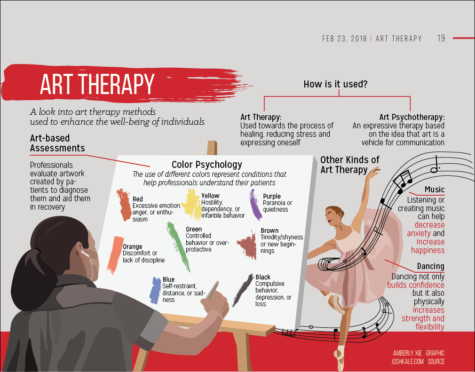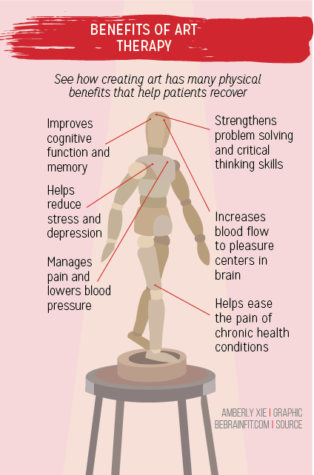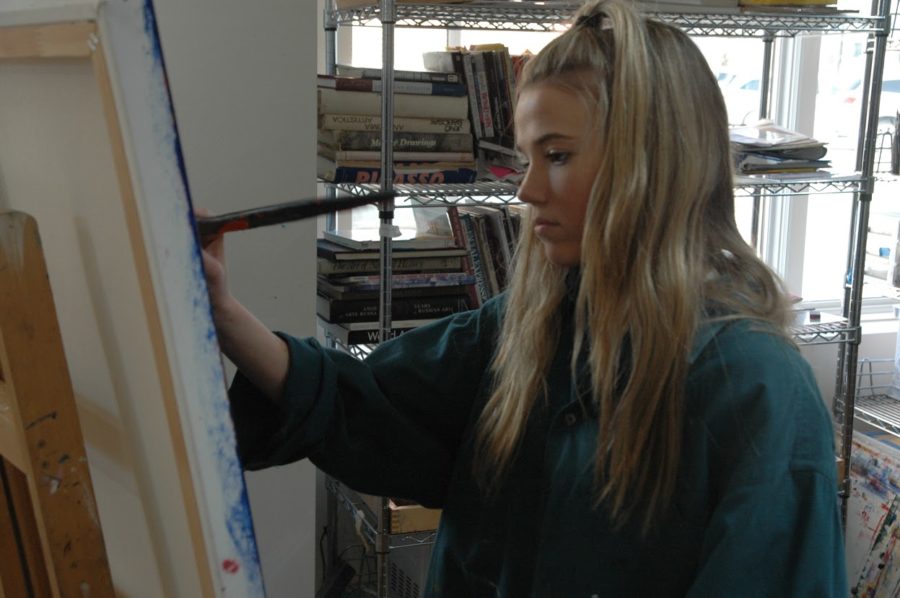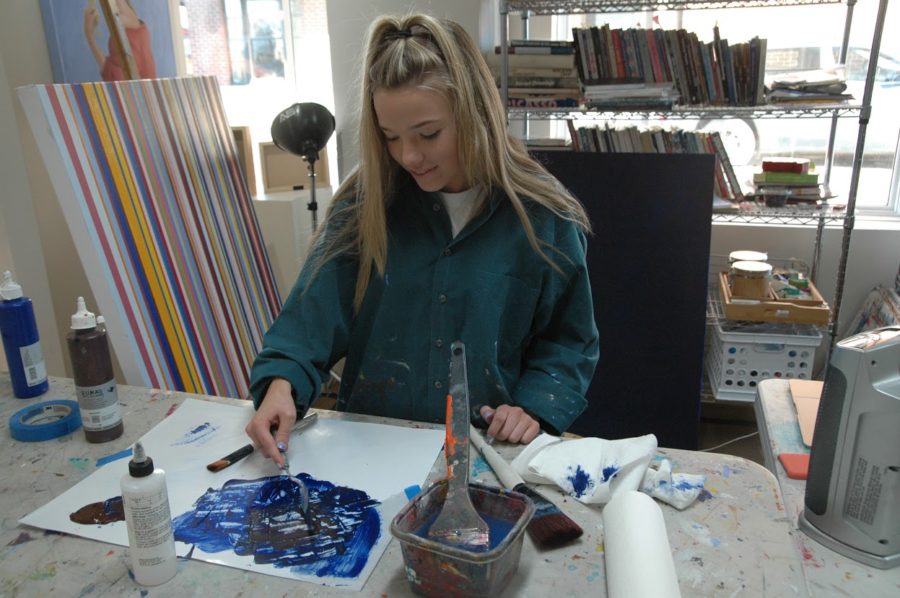
A group of young artists with disabilities crowd in a pod, equipped with paint, boards and canvases; however, these students paint for purposes beyond simply creating artwork.
Gressa Crowley, teaching assistant at Magdalena Academy of Art and sophomore, said, “People create artwork out of their own unique experiences and interpret other people’s artworks based on their own unique experiences. These life experiences may even involve disabilities. But, everyone will benefit.”
Many students enjoy using art as a means of expression but may be more than recreational; it can be therapeutic.
Crowley said she has witnessed and helped other students experience the healing powers of artmak
ing. Some professionals in art therapy thus seek to spread its awareness.
Art therapist Maggie Girard said the field of art therapy needs research and publicity. She said art therapy is a growing field that will progress with technology because research is essential in the growth of the field. The more art therapists work with different types of patients, the more they know, and then their findings can be taken seriously for more city funding and allow them to do more work.
She said, “I hope the future of art therapy is bright. I hope the field becomes more common and better known and receives more accessible funding. A lot of job listings aren’t specific to art therapists because people are not familiar enough with the field. But, art therapy can really help anyone; there’s no wrong way to do it. Art therapy sessions exist in diverse settings and will help people see the world and themselves in a new light.”
Magdalena Hoyos-Segovia, who is a painter and art teacher at Magdalena Academy of Art, said art teachers at the academy are trying to figure out ways to teach art therapy to different students in different ways since some students with disabilities may behave less consciously than how students without disabilities would behave.
Hoyos-Segovia said, “The difference with students with disabilities versus students without disabilities is related to mindset of ‘art is way for me to show how I feel without words’ versus; art is a way for me to relax.’ As a teacher, when working with students with disabilities, I need to be more careful, but I can also be more raw. They need more direct directions and defined limitations; they are not helped with hundreds of choices.”
She said therapy itself involves patients expressing themselves, so they can hear themselves and meditate about what they are saying and that art could merge with therapy because colors and lines, whether figurative or landscape-like, will express emotion.
“Reflection of these emotions does not require a certain level of consciousness. Rather, it will help students echo emotion from their work and, therefore, imply some level of emotional consciousness,” Hoyos-Segovia said.
Girija Kaimal, assistant professor of art therapy at Drexel University, led a study published in 2016, which examined the effects of artmaking on stress-related hormones in the body. The study found that 45 minutes of artmaking could lessen stress regardless of experience or talent, proving the theory that artmaking can be healing.
According to Kaimal, it is that spirit of inclusion that has contributed to the growth of this field.

Crowley said teaching art and making art are both therapeutic and have promoted her overall mental wellness. In fact, Crowley said she admits she was not interested in art before becoming an art assistant for the Magdalena Academy of Art, but now, she said art is her main stress-reliever.
Crowley said, “For me, artmaking and teaching are distractions from my personal issues. I always tell my students that art is therapeutic for them because they like it, and they feel connected to it.”
Girard said students seeking art therapy do not need art backgrounds.
She said, “We art therapists can’t read minds, so we are learning with our clients. Each client is the expert of his or her own life; as art therapists, we just look for deeper meanings in the work clients produce during sessions.”




























![Keep the New Gloves: Fighter Safety Is Non-Negotiable [opinion]](https://hilite.org/wp-content/uploads/2024/12/ufcglovescolumncover-1200x471.png)
















































![Review: “We Live in Time” leaves you wanting more [MUSE]](https://hilite.org/wp-content/uploads/2024/12/IMG_6358.jpg)
![Review: The premise of "Culinary Class Wars" is refreshingly unique and deserving of more attention [MUSE]](https://hilite.org/wp-content/uploads/2024/12/MUSE-class-wars-cover-2.png)
![Introducing: "The Muses Who Stole Christmas," a collection of reviews for you to follow through winter [MUSE]](https://hilite.org/wp-content/uploads/2024/12/winter-muse-4.gif)
![Review: "Meet Me Next Christmas" is a cheesy and predictable watch, but it was worth every minute [MUSE]](https://hilite.org/wp-content/uploads/2024/11/AAAAQVfRG2gwEuLhXTGm3856HuX2MTNs31Ok7fGgIVCoZbyeugVs1F4DZs-DgP0XadTDrnXHlbQo4DerjRXand9H1JKPM06cENmLl2RsINud2DMqIHzpXFS2n4zOkL3dr5m5i0nIVb3Cu3ataT_W2zGeDAJNd_E-1200x884.jpg)
![Review: "Gilmore Girls", the perfect fall show [MUSE]](https://hilite.org/wp-content/uploads/2024/11/gilmore-girls.png)
![Review in Print: Maripaz Villar brings a delightfully unique style to the world of WEBTOON [MUSE]](https://hilite.org/wp-content/uploads/2023/12/maripazcover-1200x960.jpg)
![Review: “The Sword of Kaigen” is a masterpiece [MUSE]](https://hilite.org/wp-content/uploads/2023/11/Screenshot-2023-11-26-201051.png)
![Review: Gateron Oil Kings, great linear switches, okay price [MUSE]](https://hilite.org/wp-content/uploads/2023/11/Screenshot-2023-11-26-200553.png)
![Review: “A Haunting in Venice” is a significant improvement from other Agatha Christie adaptations [MUSE]](https://hilite.org/wp-content/uploads/2023/11/e7ee2938a6d422669771bce6d8088521.jpg)
![Review: A Thanksgiving story from elementary school, still just as interesting [MUSE]](https://hilite.org/wp-content/uploads/2023/11/Screenshot-2023-11-26-195514-987x1200.png)
![Review: "When I Fly Towards You", cute, uplifting youth drama [MUSE]](https://hilite.org/wp-content/uploads/2023/09/When-I-Fly-Towards-You-Chinese-drama.png)
![Postcards from Muse: Hawaii Travel Diary [MUSE]](https://hilite.org/wp-content/uploads/2023/09/My-project-1-1200x1200.jpg)
![Review: "Ladybug & Cat Noir: The Movie," departure from original show [MUSE]](https://hilite.org/wp-content/uploads/2023/09/Ladybug__Cat_Noir_-_The_Movie_poster.jpg)
![Review in Print: "Hidden Love" is the cute, uplifting drama everyone needs [MUSE]](https://hilite.org/wp-content/uploads/2023/09/hiddenlovecover-e1693597208225-1030x1200.png)
![Review in Print: "Heartstopper" is the heartwarming queer romance we all need [MUSE]](https://hilite.org/wp-content/uploads/2023/08/museheartstoppercover-1200x654.png)





